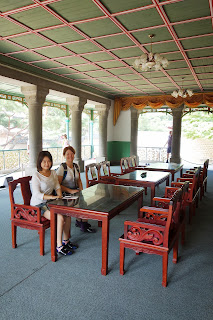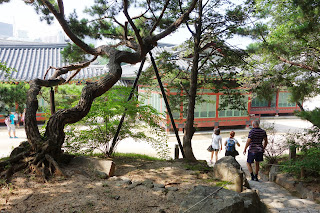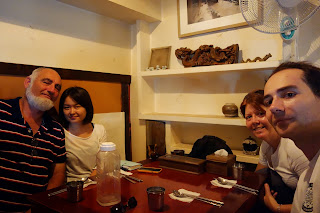My parents have come to visit me in Korea for a few days. My parents arrived while I was still busy with my English camp and spent the first couple of days checking out the markets and climbed Namsan Mountain. Once my English camp was over I headed to Seoul to do some travelling with my parents before bringing them back to Daejeon where they would meet Jihyeon's parents. In Seoul I picked a hotel a short walk from Central Station for them to stay in. It was an excellent location within walking distance of heaps of stuff to see and do. The hotel was clean and modern and the staff were friendly and helpful. I would recommend it to anyone staying in Seoul for a few days.
There were three palaces within walking distance of where we were staying. Changdeokgung, Gyeongbokgung and Deoksugung. First stop was Deoksugung (also known as Gyeongun-gung) which is right next to city hall.
Deoksugung Palace
Deoksugung is a walled compound of palaces that was inhabited by Korean royalities until the turn of the 20th century. It is one of the five grand palaces built by the kings of the Joseon Dynasty. After Emperor Gojong died in 1919, the Japanese sold part of the area and then in 1933 most of the remaining uildings were removed and the land was redeveloped as a public park. During the japanese occupation, Deoksugung suffered so much alteration that its original form is nearly impossible to discern. Deoksugung served as the symbolic heart of Korea through several national crises, including the Japanese invasion of 1592 and the tumultuous closing years of the Great Han Empire. Enough history. Picture time :)
Pictured below are the sleeping quarters of Emperor Gojong.
This building was designed by a Russian architect and incorporates both western and Korean features and was completed in 1900. Emperor Gojong enjoyed coffee and held banquets for foreign envoys here.
Our tour guide and my fiancé showing us around.
Not content with his old sleeping quarters, Emperor Gojong built a western style stone building (in the right of the picture) to be his sleeping quarters and an audience hall. In 1938 the Japanese expanded the west wing of Seokjojeon (original building on the right) for an art museum.
Pictured here is Junghwajeon, the main hall of the palace. Junghwajeon served as the main throne hall of Deoksugung and was used for ceremonial occasions such as coronations and receiving of foreign envoys. It originally had a two tiered roof, but was rebuilt as a single tiered structure in 1906 after the building burnt down in 1904.
Even though it was only built as a single tiered building, it was still bloody big.
View from Junghwajeon. You can see the new (controversial) city hall building behind the trees. The Japanese find it offensive because it looks like a tidal wave washing over the old (Japanese built) city hall. Picture here.
Panorama of Junghwajeon.
Photo with the guard at the front gate of Deoksugung palace.
We then started walking up the street to Gyeongbokgung palace. On the way we passed a couple of large statues. The first was general Yi Sun-sin who is famous for his naval victories against the Japanese navy during the Imjin war. He is well respected for his exemplary conduct on and off the battlefield not only by Koreans, but by Japanese Admirals as well. His most remarkable military achievement was defeating 333 Japanese naval ships with just 13 Korean naval ships. Despite never having received naval training or participating in naval compat prior to the war, and constantly being outnumbered and outsupplied, he went to his grave as one of the few admirals in world history who remained undefeated after commanding as many naval battles as he did (at least 23). He died on December 16, 1598 at the battle of Noryang. With the Japanese army on the verge of being completely expelled from the Korean Peninsular, he was mortally wounded by a single bullet. His famous dying words were, "The battle is at its height... beat my war drums... do not announce my death."
A little further up the road was a statue of King Sejong (also known as Sejong the Great). Under his leadership Korea technologically advanced. He also revolutionized government and strengthened the Korean military. One of his greatest and long lasting achievements was Hangul (the Korean alphabet). Before Hangul, Koreans used the Chinese alphabet which was difficult to master. Due to the high level of difficulty only rich people with time to spend studying could master the language. Sejong recognized the importance of reading and writing and that all people should be able to read and understand the laws and represent themselves in a dispute. He also placed a great deal of importance of education and knowledge, of which literature is key. He reinvented a simpler 28 letter alphabet with the explicit goal being that Koreans from all classes would read and write.
Gyeongbokgung Palace
Next stop was Gyeongbokgung palace. It was first constructed in 1395 but then later burned and abandoned for almost three centuries. It was reconstructed in 1867 and was the main and largest palace of the five grand palaces built by the Joseon Dynasty. In the early 20th century, much of the palace was destroyed by Japan. Since then, the walled palace complex as been slowly restored back to its original form.
View from the throne hall looking back towards Seoul.
Pictured here is building where Hangeul (the Korean alphabet) was invented by King Sejong.
Below is Gyeonghoeru pavilion which is where the king threw formal banquets for foreign envoys. The King and his party could enjoy sweeping views of the palace and Mount Inwangsan from this building.
In the rear garden of the concubines' quarters is a square pond with an island in the center. On the island is a hexagonal pavilion.
A random flower in the garden.
King Gojong built this Geoncheonggung (pictured below) in 1873 to forge political independence from this father.
Then, it was lunch time. I didn't capture it well in this picture, but to maximise the space in the restaurant, the owner created a mezzanine floor to squeeze some more tables in. It was very small and cramped and it was impossible to stand up. In this picture we are sitting on the floor.
Changdeokgung Palace
After lunch we headed to Changdeokgung Palce which is also home of a secret garden that was traditionally reserved for royalty and guests of the king.
Map to the no so secret garden.
Walking to the secret garden.
Waiting at the entrance to the secret garden.
This area is the heart of the Secret Garden.
The king would sit in the building in the left of the picture with other officials and have parties and go fishing. Only the King was allowed to go fishing. He would sit in the (slightly higher) area that hangs over the pond while the officials would sit in the lower (less important) area.
In a different part of the garden are a couple of buildings dedicated to study. They are very simple structures and not adorned with any decorations or colours. The king didn't want to be distracted while he was studying.
The buildings below were built by prince Hyomyeong in 1828 to hold the Jinjakrye ceremony to celebrate the 40th birthday of his mother. After celebrating his mothers birthday, the buildings served as a venue to receive foreign envoys and throw parties with political overtones.
Here you can see the three rooms connected internally by doors between each of the rooms. In Confucianism men an women would sleep in separate rooms. The far room is where the King would sleep, the room in the middle is where the kings mother would sleep, and the closest room is where the Queen would sleep. Want to spend some time with the Queen? You gotta go through your mothers room first ;).
Next stop, another pavilion next a pond. This one was built in 1644.
My mum and Jihyeon on a stone bridge next to the pavilion above.
Yet another pavilion, this one was next to a small stream. In 1636, during the reign of King Injo, a U-shaped groove was carved on a large flat rock known as Soyoam and filled with water. Sometimes the king and his officials set afloat their wine cups on the water while they wrote poetry. If the wine cup traveled all the way around the U-shaped grove and went over the edge of the waterfall before they could write a poem, they were punished. The punishment was drinking more wine and trying again.
Here you can see the U-shaped grove carved into the rock.
Just behind the U-shaped grove where the King and his officials would write poetry was a small rice field with King would tend to all by himself. He did this so he could better understand the hardship of the peasants and know when the season was good and when it was bad. After the rice season had finished, he would re-thatch the small pagoda behind the rice field himself too.
The Chinese juniper in this picture is believed to be 750 years old. It is 12 meters high. Juniper wood is very aromatic and is used to make incense for rituals. This aromatic tree was planted here to provide incense for ancestral rituals at Seonwonjeon Shrine(just behind the tree), where portraits of former kings were enshrined.
After the Secret Garden tour finished, we checked out the throne hall of Changdeokgung.
Once again, the throne hall appears to be two stories, but inside it is a single space with a high, beautifully adorned ceiling. The floor of the hall was originally covered with blocks of baked clay, but today it is covered with wooden floorboards.
On the way back to our hotel we passed literally thousands of police patrolling the streets or sitting in police buses around City Hall. People were protesting something dodgy the president had done. I don't know exactly what she did, but I think the allegation was she paid people off to win the election earlier this year.
Seoul City Bus Tour
After dinner, we did a Seoul City tour of the bridges crossing the Han river.
We were up on the top floor of the bus which was kind of cool, but that is where the coolness stopped. They gave you head phones which would play an audio tour in your language, but to be frank, it was crap. It had the potential to be good. As we drove around Seoul and crossed various bridges they could have told us some interesting facts about Seoul and enlightened us to some of its history, but instead they would play a brief 30 second message (preceded by a loud beep) about the bridge we were crossing which went along the lines of "You are now crossing bridge X, the lighting symbolizes the passion of the Korean people" and what was it. As I said, complete and utter crap.
After the bus tour we headed back to our hotel. I took this shot of the new City Hall crashing down on the old Japanese built city hall.
And some pictures of more riot police patrolling the streets.
Here is a giant portable fence attached to the side of a truck that the police can deploy quickly if they need to.
The next day we caught the KTX to Daejeon where my Parents would meet Jihyeon's family (Parents, brother and sister).








































































No comments:
Post a Comment